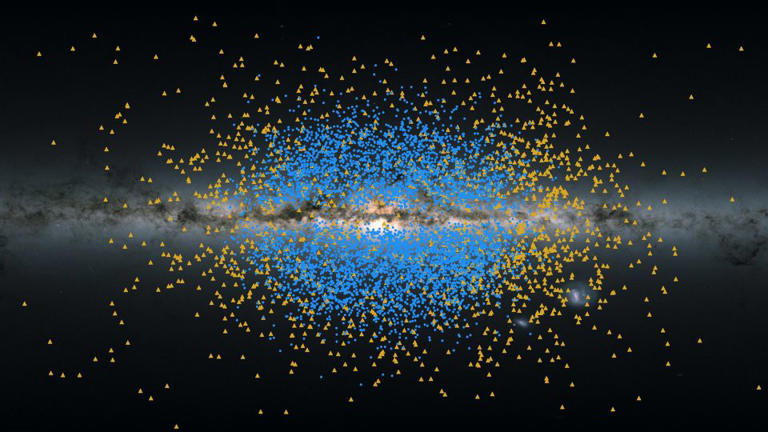Peer deep into the heart of the Milky Way, and you’ll find whispers of a bygone era etched in the tapestry of stars.
Using the European Space Agency’s Gaia space telescope, astronomers have embarked on a captivating journey of galactic archaeology, uncovering two extraordinary stellar streams – Shakti and Shiva – named after revered Hindu deities. These ancient streams, believed to be the remnants of dwarf galaxies, offer a glimpse into the Milky Way’s earliest chapters, a time when galaxies were just beginning to form in the nascent universe over 12 billion years ago.
Fossil Stars: Unveiling a Galactic Merger
Shakti and Shiva stand out from the crowd. Unlike the younger stars that populate the Milky Way’s iconic spiral arms and central disk, these stellar relics boast an antiquity that dwarfs even the galaxy’s most seasoned inhabitants. The discovery, detailed in a recent study published in The Astrophysical Journal, sheds light on the Milky Way’s earliest history and the growth processes that shaped massive galaxies across the cosmos.
“What’s truly amazing is that we can even detect these ancient structures,” marvels Dr. Khyati Malhan, lead author of the study and a researcher at Stockholm University. “The Milky Way has undergone such dramatic transformations since these stars were born that we wouldn’t expect to find them as a cohesive group. But Gaia’s exceptional data has made it possible.”
Gaia: Illuminating the Galaxy’s Origins
Launched in 2013, Gaia has become a game-changer in our understanding of the Milky Way. By meticulously measuring the positions, distances, and movements of nearly 2 billion stars within our galaxy, Gaia has unveiled previously unknown structures and provided astronomers with a treasure trove of data to piece together the Milky Way’s grand narrative.
In 2022, researchers, including study co-author Hans-Walter Rix, used Gaia’s data to peer into the very heart of the Milky Way during their “galactic archaeology” mission, uncovering the galaxy’s oldest known stars. This new analysis focused on a distinct set of stars observed by Gaia and the Sloan Digital Sky Survey, revealing two peculiar streams that defied categorization.
Chemical Fingerprints Unlock the Past

The survey data provided valuable insights, acting as a chemical fingerprint to unlock the past. “We observed a specific group of metal-poor stars concentrated around two distinct combinations of energy and angular momentum,” explained Dr. Malhan.
Located near the Milky Way’s core, both Shakti and Shiva are estimated to contain the mass of roughly 10 million suns each. These ancient stars share striking similarities in age, orbital path, and composition, strongly suggesting they originated from a single external source that eventually became woven into the fabric of the Milky Way.
A Galactic Archaeology Triumph
The researchers likened the discovery of Shiva and Shakti to uncovering the foundational remnants of an ancient settlement that blossomed into a thriving metropolis. “These stars are incredibly old, lacking the abundance of heavier elements forged within stars over time,” said Dr. Rix. “The metal-poor nature of stars in the Milky Way’s heart led us to call it the galaxy’s ‘poor old heart.'”
“Previously, we only recognized fragments that coalesced to form the Milky Way’s ancient core. Now, with Shakti and Shiva, we have the first indications of structures comparably old, but further out. These streams represent the initial stages of our galaxy’s growth into its present form,” he added.
Tracing the Milky Way’s Growth Spurt
The Milky Way wasn’t always the majestic spiral galaxy we know today. It began as a much smaller entity, growing in stature through mergers with other galaxies. These mergers not only bolstered its stellar population but also enriched its hydrogen gas reserves, the fuel that ignites the fires of star formation. As these galactic collisions transpired, the interstellar gas clouds were disrupted, triggering bursts of star birth.
Over countless eons, the Milky Way’s once-filamentary gas and dust coalesced, giving rise to the magnificent spiral arms that grace our galaxy today.
Gaia: Unveiling a Galactic Tapestry
Gaia’s contribution to galactic archaeology is invaluable. It has not only helped astronomers pinpoint the timing of past merger events but also holds the promise of further revelations. “Gaia is fulfilling its objective of uncovering our galaxy’s infancy,” said Timo Prusti, Gaia project scientist at the European Space Agency.
“Understanding the Milky Way’s formation and evolution hinges on identifying subtle yet crucial differences between its stars. Gaia’s incredibly precise data is paramount in this endeavor. As we discover unexpected components like the Shiva and Shakti streams, we’re progressively filling the gaps and building a more comprehensive picture of not just our galactic home, but also our cosmic origins,” he concluded.
The discovery of Shiva and Shakti is a testament to Gaia’s remarkable capabilities



















